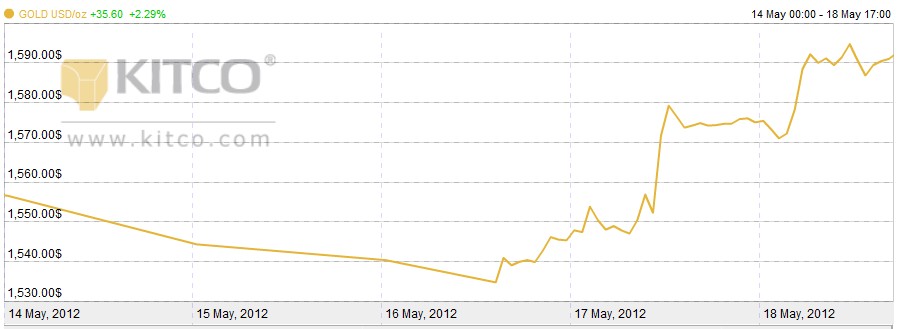Monday Open: $1,556.83
Weekly High: $,1597.57
Weekly Low: $1,529.50
Friday Close: $1,591.98

The price of gold took two tumultuous turns last week, opening at a relatively stable $1,550 per ounce, dropping to a drastically weak low on Wednesday, and then rebounding dramatically to return to this year’s base average around $1,600 per ounce.
Gold has been dropping up and down this year as the dollar and euro bounce back and forth, and this past Wednesday marked a major turning point in the euro. Greece’s efforts to form a new government fell short of expectations, causing the euro to drop and the dollar to rise. Investors who have been counting on a higher gold price lost their appetite for risk after Wednesday’s financial troubles, and there was a massive pull out of the market. Gold dropped to its lowest point since December, largely fueled by a fear that Greece would pull out the euro zone and thus worsen Europe’s debt crisis.
“Everybody is rushing to buy the U.S. dollar. A strong dollar is negative for gold for the time being,” said Ronald Leung on Wednesday. He is the director of Lee Cheong Gold Dealers in Hong Kong.
Since gold is such a speculative market, many investors wonder when “the bubble will burst.” Leung also expressed how jewelers were decreasing their demand for the metal, since prices are so volatile.
“Gold under $1,500 might come in the next few sessions, which would likely precipitate a fall below $1,400 an ounce in the next couple of months,” predicts Michael K. Smith of T&K Futures in Florida. This would be a major downturn, since gold has been on a steady rise, hitting its peak last year at nearly $2,000 per ounce.
Yet, the knee-jerk reaction to Wednesday’s turbulence was directly followed by a sharp two-day spike that countered any immediate fears of further downturn. Since gold trades inversely to the dollar, on Wednesday investors started moving shares from the now-risky gold market into safer investments, like, surprisingly, the U.S. dollar.
However, U.S. economic reports hit the stands on Thursday, sending mixed signals about the future strength of the dollar. Joblessness claims have fallen, but manufacturing and construction have not expanded as expected, and personal incomes and personal spending rose slightly, but not as much as predicted.
Even more significantly, the Philadelphia Federal Reserve reported a lessening of factory activity in the mid-Atlantic region, giving investors hope that the Fed might soon pour more money into economic stimulus. If this happens, the dollar would be further weakened. After the news broke, the previous day’s low spiked $24 in a mere 20 minutes.
Leave a Reply